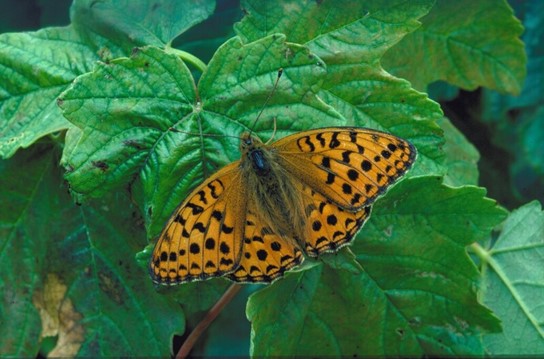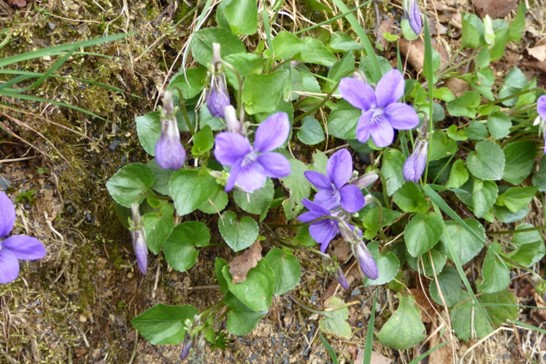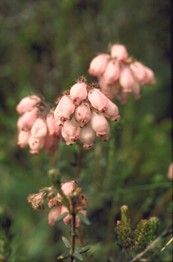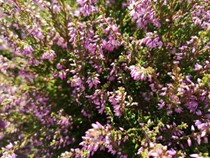Old Castle Down SSSI - Grazing to Help Wildlife
Overview
Cliciwch yma i ddarllen y dudalen yn Gymraeg / Click here to read this page in Welsh
Old Castle Down
Old Castle Down is designated as a Site of Special Scientific Interest (SSSI) due to several distinct features including limestone grassland, limestone heath and humid heath. The variation in these plant communities reflects the changes in the calcium carbonate content of the soils.
On the west side of the B4265 the calcareous grassland is dominated by sheep’s fescue grass (Festuca ovina). Wild thyme (Thymus drucei), common rockrose (Helianthemum nummularium) and fairy flax (Linum catharticum) are also common above the slopes on either side of the road. Crested hairgrass (Koeleria macrantha), quaking grass (Briza media), soft-leaved sedge (Carex disperma), carline thistle (Carlina vulgaris), mouse-ear hawkweed (Pilosella officinarum), salad burnet (Sanguisorba minor) and squinancywort (Asperula cynanchica) are also typical representatives of the habitats here.
Also on the slopes are extensive areas of damp limestone heath. Here, cross-leaved heath (Erica tetralix), bell heather (Erica cinerea) and western gorse (Ulex gallii) dominate a species-rich mix of tormentil (Potentilla erecta), lady’s bedstraw (Galium vernum), and betony (Stachys officinalis), which resembles grass/heath associations in Southwest England. This assemblage, however, is distinguished from its English counterparts by the abundance of purple moor-grass (Molinia caerulea), flea sedge (Carex pulicaris), and the nationally scarce soft-leaved sedge. Bands of common gorse (Ulex europaeus), and bracken (Pteridium spp.) have colonised the deeper soils on the slopes.
On the plateau and upper slope to the east of the B4265, more acid conditions prevail, creating a humid heath. There are close similarities with the damp calcareous heath, such as the dominant presence of western gorse and purple moor-grass, but two other grass species, bristle bent (Agrostis curtisii) and velvet bent (Agrostis canina), are also very common here.
More information on the Old Castle Down SSSI and its special features
For more information on the species above, visit the following pages on The Wildlife Trust website:
The High Brown Fritillary

Old Castle Down also provides habitat for various invertebrates, including the High Brown Fritillary (Fabriciana adippe), Britain’s most endangered butterfly.
The high brown fritillary butterfly breeds where violets grow under an open bracken canopy, on gentle slopes around the edge of the plateau.
The adult butterflies emerge from the bracken in mid-June to August and can be seen feeding from the flowers of brambles and thistles. The females lay eggs in the dead bracken leaves to incubate over winter. The eggs then hatch in early spring and the dark coloured caterpillars can be seen basking on the dead bracken and feeding on their primary foodplant, the common dog-violet (Viola riviniana).

Common dog-violet (Viola riviniana)
The bracken creates warm microclimates (15-20°C higher than the surrounding grassland vegetation) allowing the caterpillar to develop quickly. To evade predators, the caterpillars are camouflaged with feathery brown spines that mimic dead bracken fronds. They then pupate under dead bracken or leaves in loose tent-like structures which they form by spinning leaves together. The species is largely restricted to sheltered, usually south-facing, open and sunny sites below 300m altitude.
The High Brown Fritillary is Britain’s most vulnerable butterfly species, showing a great level of historical decline across Wales and the rest of the UK (with a loss of over 90% since the 1970s). Old Castle Down is now the only known site in Wales that supports a colony of High Brown Fritillary. Due to its high vulnerability to extinction, the High Brown Fritillary is a priority species under the UK Biodiversity Action Plan, listed on Section 7 of the Environment (Wales) Act 2016, and protected in the UK under the Wildlife and Countryside Act, 1981. It is also listed as a high priority species by Butterfly Conservation.
For more information on the High Brown Fritillary visit the Butterfly Conservation website.
Grazing for Conservation
A major factor causing the historical decline of the High Brown Fritillary is the decrease in traditional forms of bracken and scrub management, including cattle grazing. The reduction of cattle grazing allows bracken and scrub to dominate and out compete the other ground flora vital for the species existence.
To restore heath and grassland communities, and create more habitat for High Brown Fritillary, grassland cattle have been introduced to Old Castle Down to enhance the heath and grassland mosaics and prevent encroachment of scrub. Extensive cattle grazing will take place during winter and early spring (February to April).
If grazing takes place between April and June, it is usually light and extensive to ensure nectar sources for adults are not removed. The aim of this project is to build a resilient, stable, and sustainable High Brown Fritillary population and increase the available area of suitable habitat to enable the population to increase and expand.
Visitors to the site are advised to not feed the grazing animals and to give them plenty of space. Remember to stay calm and walk slowly. Dog walkers, please keep your dog on a short lead.
For more information on bracken management visit the following links:
Cross-leaved heath (Erica tetralix)

Common heather (Calluna vulgaris)

Contact: cardiff&vale.environmentteam@cyfoethnaturiolcymru.gov.uk
Areas
- All Areas
Audiences
Interests
- Biodiversity

Share
Share on Twitter Share on Facebook